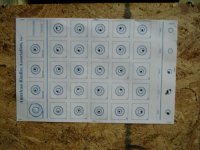Electrical Discharge Machining will not leave a burr - and could actually "drill" curved, square (or rectangular) holes.
Very true, the process wasn't invented ,or at least available for use in gunsmithing back in the old days.
The methods I mentioned are much more low tech and can be done with the sort of equipment most people have available, drill press etc.
If the hole is first drilled til only the very tip emerges then the slight raised area around it is lapped flush it will bring the opening to near full dia.
Any thinned lip left at the bottom of the hole would tend to be pushed back into the hole by gas pressure the first few times the gun is fired leaving at most a smoothly rounded edge turned inward to the hole and nothing protruding into the bore.
Not sure but this might also give it a slight venturi profile to speed up the velocity of expended gas. Less gas escape for the same effect as a larger hole.
Haven't tried this yet, just seems like thats how it would work.
PS
I have made tiny holes in thin very hard spring steel which my drills wouldn't bite by using a punch to make a dent then using a whetrock to grind away the bump on the other side. That gave me the idea.
I've used that method to make a replacement hand spring from pieces of stripper clip springs , with a pin hole to lock it in the groove in the hammer by way of drilling a hole and driving in a small pin.
Some of these I'd repaired, from repro C&B pistols, had the outside of the slot broken away completely. The pin holds the spring in place better than the original method of holding these in place.
Also some like to drill the holes normally then counter bore from the muzzle leaving a free bore section.
Works okay for some low velocity calibers, but its risky for high accuracy barrels.



